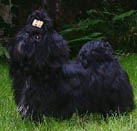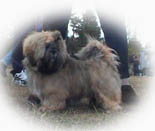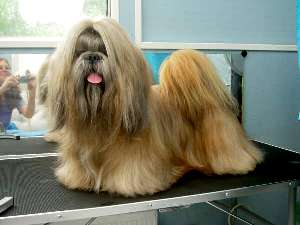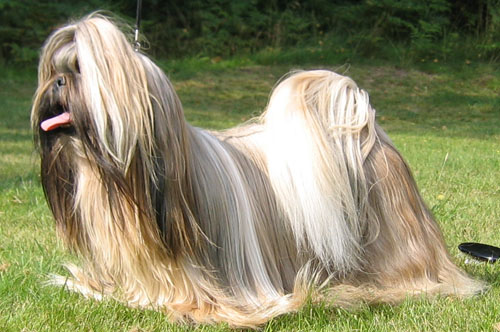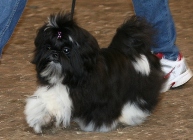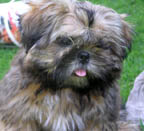

This small sturdy dog, like the Lhasa Apso, is covered over with an abundant double coat of long hair lined with a woolly undercoat. This proud looking little dog has hair above the nose growing upward, creating a "chrysanthemum" face. The head is rounded, with a profuse beard and mustache, short hairy muzzle, and black nose (except in liver-colored dogs which have liver noses). There is a definite stop. The eyes are large, round and wide-set, dark on most dogs but lighter on liver and blue colored dogs. The pendant ears are so covered with hair that they blend right into the body coat. The teeth should form a level or undershot bite. The topline is level and the body is slightly longer than the height at the withers. Dewclaw removal is optional. The heavily plumped tail is curled over the back. Any color is acceptable, though white on the forehead and tip of the tail is preferred by most dog show judges.
These little dogs require a good daily grooming using a bristle brush. A topknot is usually tied with a bow so that the dog can see properly. Some owners prefer to have them trimmed to make the coat easier and less time consuming to care for. Keep the ear passages and area around the eyes clean. Shih-Tzu's have sensitive eyes that should be keep clean. There is special drops you can buy to put in them if needed. Ask your vet what to use on your dog. This breed sheds little to no hair and are good for allergy suffers if their coats are kept very well groomed. (Due the fact that they shed little skin dander.)
Documents and paintings dating from the sixteenth century show dogs resembling a small lion (which the Shih-Tzu is sometimes called). In the seventeenth century, dogs were brought from Tibet and bred in the forbidden City of Peking, probably by crossing the Tibetan Lhasa Apso and the native Pekingese. The Shih-Tzu became a favorite of the Imperial Chinese court. The breed was so revered that for many years after the Chinese began trading with the West, they refused to sell, or even give away, any of the little dogs. It was not until 1930 that the first pair was imported to England. The Shih-Tzu was recognized in Britain in 1946.
